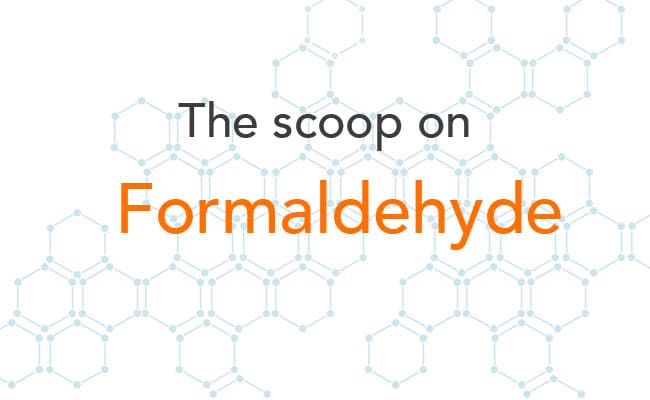
What is formaldehyde?
Formaldehyde is a commonly used preservative. It can be aded directly or instead released by other preservatives. It is a flammable, colorless gas with a strong and distinctive smell [3]. It’s a common indoor air pollutant because of its use in home construction materials as well as a byproduct of chemical reactions that take place in cleaning products [2] [4].
What products is formaldehyde in?
Formaldehyde is in lots of products, including those as seemingly safe as baby washes and shampoos. It is found in cosmetics, cleaning products, air fresheners, glues, paints, hair straighteners, and detergents as well as certain pressed-wood construction products like cabinets, furnishings, plywood or particleboard and laminate flooring. Certain permanent press fabrics may also contain formaldehyde [3] [2] [1]. Personal care products may become contaminated with formaldehyde over time when common preservatives chemically react with Quaternium-15 [5].
How to tell if a product has formaldehyde
Formaldehyde may also be called formalin, urea formaldehyde, or phenol formaldehyde but sometimes it isn’t listed on the ingredients label because it wasn’t actually added to the product. Rather, formaldehyde may be a byproduct of chemical reactions with formaldehyde-releasing preservatives like bronopol [2] [4] [5].
Risks associated with formaldehyde
Ongoing exposure to formaldehyde in the home as a result of construction materials can cause toxic effects in children as well as adults. Short term exposure, however, is also an issue. Short term exposure to formaldehyde can cause skin and mucous membrane allergies, asthma, flu-like symptoms, cancer [2]. Low-level but ongoing exposure can cause eye, nose, skin, and throat irritation as well as asthma [3].
How to avoid formaldehyde
There is a long lost of chemicals that could fall within this group, so look for the words “formaldehyde- free” and/or avoid these chemicals if noted: formaldehyde, quaternium-15, dimethyl-dimethyl (DMDM) hydantoin, imidazolidinyl urea, diazolidinyl urea, sodium hydroxymethylglycinate, 2-bromo-2-nitropropane-1,3-diol (most commonly known as bronopol). In cleaning products, where manufacturers aren’t required to list all their ingredients on product labels, choose toxic chemical free alternatives with safe natural ingredients. Also remember that there are no federal criteria dictating standards for what makes something a “natural” cleaner, so avoid cleaners with fragrances & preservatives.
Most homes today are constructed with materials that emit formaldehyde. Rather than removing the offending materials, it is possible to diminish formaldehyde emissions to near non-existent levels over time [2].
References:
[1] Women’s Voices for the Earth (2015). Formaldehyde still found in hair straighteners. Available online: http://www.womensvoices.org/2015/10/16/formaldehyde-still-found-in-hair-straighteners/ December 7, 2016.
[2] Healthy Child Healthy World (2013). Keep formaldehyde out of indoor air. Available online: http://www.healthychild.org/easy-steps/keep-formaldehyde-out-of-indoor-air/ December 7, 2016.
[3] Agency for Toxic Substances and Disease Registry (2016). Available online: https://www.atsdr.cdc.gov/formaldehyde/ December 7, 2016.
[4] EWG (2007-2016). Cleaning supplies and your health. Available online: http://www.ewg.org/guides/cleaners/content/cleaners_and_health December 7, 2016.
[5] Women’s Voices for the Earth (2016). No More Toxic Tub. Available online: http://www.womensvoices.org/no-more-toxic-tub/ December 7, 2016.



